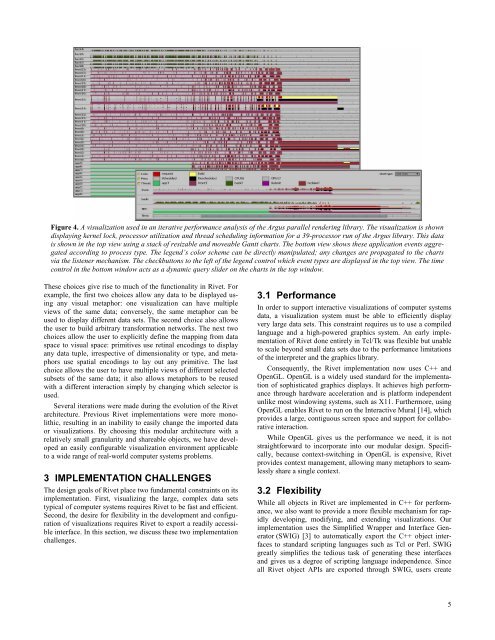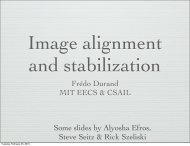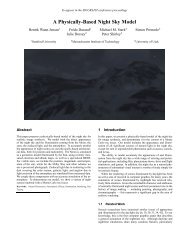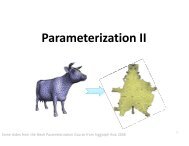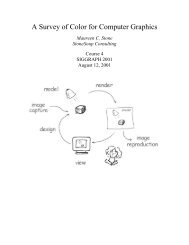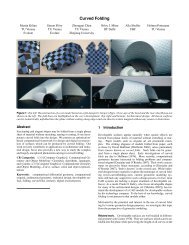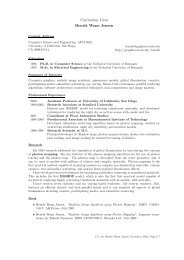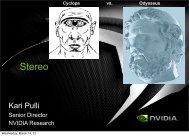Rivet: A Flexible Environment for Computer Systems Visualization
Rivet: A Flexible Environment for Computer Systems Visualization
Rivet: A Flexible Environment for Computer Systems Visualization
You also want an ePaper? Increase the reach of your titles
YUMPU automatically turns print PDFs into web optimized ePapers that Google loves.
Figure 4. A visualization used in an iterative per<strong>for</strong>mance analysis of the Argus parallel rendering library. The visualization is shown<br />
displaying kernel lock, processor utilization and thread scheduling in<strong>for</strong>mation <strong>for</strong> a 39-processor run of the Argus library. This data<br />
is shown in the top view using a stack of resizable and moveable Gantt charts. The bottom view shows these application events aggregated<br />
according to process type. The legend’s color scheme can be directly manipulated; any changes are propagated to the charts<br />
via the listener mechanism. The checkbuttons to the left of the legend control which event types are displayed in the top view. The time<br />
control in the bottom window acts as a dynamic query slider on the charts in the top window.<br />
These choices give rise to much of the functionality in <strong>Rivet</strong>. For<br />
example, the first two choices allow any data to be displayed using<br />
any visual metaphor: one visualization can have multiple<br />
views of the same data; conversely, the same metaphor can be<br />
used to display different data sets. The second choice also allows<br />
the user to build arbitrary trans<strong>for</strong>mation networks. The next two<br />
choices allow the user to explicitly define the mapping from data<br />
space to visual space: primitives use retinal encodings to display<br />
any data tuple, irrespective of dimensionality or type, and metaphors<br />
use spatial encodings to lay out any primitive. The last<br />
choice allows the user to have multiple views of different selected<br />
subsets of the same data; it also allows metaphors to be reused<br />
with a different interaction simply by changing which selector is<br />
used.<br />
Several iterations were made during the evolution of the <strong>Rivet</strong><br />
architecture. Previous <strong>Rivet</strong> implementations were more monolithic,<br />
resulting in an inability to easily change the imported data<br />
or visualizations. By choosing this modular architecture with a<br />
relatively small granularity and shareable objects, we have developed<br />
an easily configurable visualization environment applicable<br />
to a wide range of real-world computer systems problems.<br />
3 IMPLEMENTATION CHALLENGES<br />
The design goals of <strong>Rivet</strong> place two fundamental constraints on its<br />
implementation. First, visualizing the large, complex data sets<br />
typical of computer systems requires <strong>Rivet</strong> to be fast and efficient.<br />
Second, the desire <strong>for</strong> flexibility in the development and configuration<br />
of visualizations requires <strong>Rivet</strong> to export a readily accessible<br />
interface. In this section, we discuss these two implementation<br />
challenges.<br />
3.1 Per<strong>for</strong>mance<br />
In order to support interactive visualizations of computer systems<br />
data, a visualization system must be able to efficiently display<br />
very large data sets. This constraint requires us to use a compiled<br />
language and a high-powered graphics system. An early implementation<br />
of <strong>Rivet</strong> done entirely in Tcl/Tk was flexible but unable<br />
to scale beyond small data sets due to the per<strong>for</strong>mance limitations<br />
of the interpreter and the graphics library.<br />
Consequently, the <strong>Rivet</strong> implementation now uses C++ and<br />
OpenGL. OpenGL is a widely used standard <strong>for</strong> the implementation<br />
of sophisticated graphics displays. It achieves high per<strong>for</strong>mance<br />
through hardware acceleration and is plat<strong>for</strong>m independent<br />
unlike most windowing systems, such as X11. Furthermore, using<br />
OpenGL enables <strong>Rivet</strong> to run on the Interactive Mural [14], which<br />
provides a large, contiguous screen space and support <strong>for</strong> collaborative<br />
interaction.<br />
While OpenGL gives us the per<strong>for</strong>mance we need, it is not<br />
straight<strong>for</strong>ward to incorporate into our modular design. Specifically,<br />
because context-switching in OpenGL is expensive, <strong>Rivet</strong><br />
provides context management, allowing many metaphors to seamlessly<br />
share a single context.<br />
3.2 Flexibility<br />
While all objects in <strong>Rivet</strong> are implemented in C++ <strong>for</strong> per<strong>for</strong>mance,<br />
we also want to provide a more flexible mechanism <strong>for</strong> rapidly<br />
developing, modifying, and extending visualizations. Our<br />
implementation uses the Simplified Wrapper and Interface Generator<br />
(SWIG) [3] to automatically export the C++ object interfaces<br />
to standard scripting languages such as Tcl or Perl. SWIG<br />
greatly simplifies the tedious task of generating these interfaces<br />
and gives us a degree of scripting language independence. Since<br />
all <strong>Rivet</strong> object APIs are exported through SWIG, users create<br />
5


